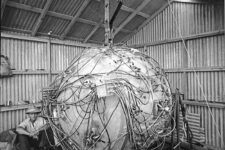
Migrant Mother by Dorothea Lange, 1936
The woman sat in a tent, her children huddled close, their faces turned away from the camera. The photographer had seen them on the side of the road, a family like so many others, adrift in a sea of uncertainty. The woman’s name was Florence Owens Thompson, but in that moment, she became something more—a symbol of the suffering and resilience of a nation.
Her face was lined with worry, her eyes filled with a weariness that seemed to stretch back generations. In her gaze, one could see the weight of the years, the toll of the hard labor and the long journeys. Her hands, rough and calloused, spoke of the work she had done, the fields she had tilled, the crops she had picked. And yet, in the midst of all that hardship, there was a strength in her, a fierce determination to keep her family together, to find a way forward.
The photograph that captured her image would become an icon of the Great Depression, a testament to the suffering and the endurance of a people. In the lines of her face, in the droop of her shoulders, in the tattered clothes of her children, the nation saw itself reflected. And in that reflection, there was a glimmer of hope, a sense that even in the darkest of times, the human spirit could not be broken.
For the migrant mother and her children were not alone in their struggles. Across the country, countless families were facing the same hardships, the same uncertainties. They were the displaced and the dispossessed, driven from their homes by drought and poverty, forced to wander in search of work and shelter. And yet, in their faces, in their stories, there was a common thread of humanity, a shared experience of pain and perseverance.
In the years to come, the photograph of the migrant mother would endure as a reminder of a time when the nation was tested, when the very fabric of society seemed to be unraveling. But it would also serve as a testament to the strength of the human spirit, to the unbreakable bonds of family and community, and to the enduring hope that even in the darkest of times, a better future could be built.









